
The Solar-Terrestrial Centre of Excellence (STCE) is a collaborative network of the Belgian Institute for Space Aeronomy, the Royal Observatory of Belgium and the Royal Meteorological Institute of Belgium.
 |
Published by the STCE - this issue : 13 Dec 2012. The Solar-Terrestrial Centre of Excellence (STCE) is a collaborative network of the Belgian Institute for Space Aeronomy, the Royal Observatory of Belgium and the Royal Meteorological Institute of Belgium. |
| Archive of the newsletters | Subscribe to this newsletter by mail |
Sunspot groups come in a variety of shapes, and it is well known that such regions occasionally team up to form an eye-catching configuration. This was the case late November and the beginning of December, when NOAA 1623 and 1625 formed a nice square of sunspots.
NOAA 1623 rounded the east limb as a mature group on 27 November, while NOAA 1625 started to form a few degrees to the north of NOAA 1623 on 29 November, developing fairly quickly. By 30 November, both groups were about as long as they were separated from each other, forming a nice square. The square's side measured over 7 heliographic degrees, corresponding to about 85.000 km or 7 Earth diameters.
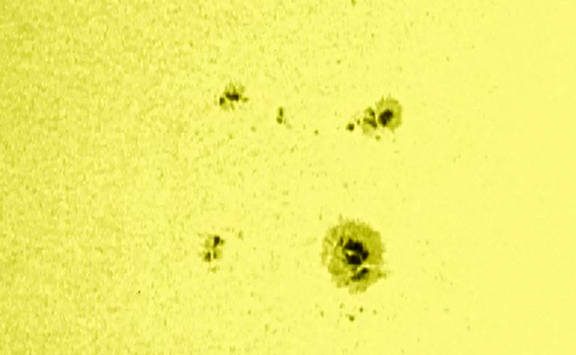
A white light movie (SDO/AIA 4500 - http://sdo.gsfc.nasa.gov/ ) was uploaded at http://www.youtube.com/watch?v=CcdBVtRHMwc and shows the evolution of both groups as they transited the solar disk (27 November – 10 December). Notice that the square was just a temporary configuration, as both sunspot groups continued to evolve independently, gradually decaying. This can also be seen in the magnetograms (SDO/HMI), where the magnetic flux starts to disappear in the trailing part of both regions (white part, i.e. positive "outgoing" magnetic polarity). This corresponds to the disappearance of the sunspots, and by 9 December, NOAA 1625 was reported to have "died on disk".
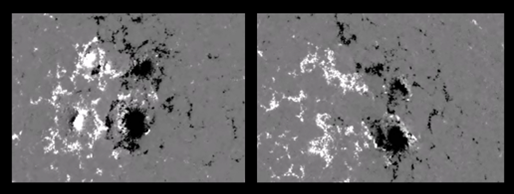
Both groups produced 8 small C-flares each, most of them on 29 November: 6 by NOAA 1625 and 5 by NOAA 1623. Though both active regions developed separately, one can see in the SDO/AIA 171 part of the movie that there is an occasional magnetic link between the trailing part of NOAA 1625 (white, positive magnetic polarity) and the leading part of NOAA 1623 (black, negative polarity).
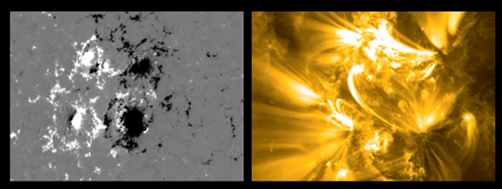
The EGU General Assembly brings together scientists covering all disciplines from the Earth, Planetary and Space Sciences.
Norma Crosby is the Programme Group Chair of the section Solar-Terrestrial Sciences, subdivided in solar physics, Magnetosphere, Heliosphere and Ionosphere.
This session is convened by Nandita Srivastava.
Christophe Marqué from the STCE and Joan Burkepile are co-convening.
The conveners invite research papers highlighting new challenges and promises that ground-based observations have to offer in the field of solar-terrestrial research. Recently, new initiatives in ground-based instrumentation have been taken up by several observatories around the world in the regime of optical, infrared and radio wavelengths. The spatial and temporal resolution of the ground-based observations complement the space-based observations, in a unique way bridging the gaps and addressing important issues pertaining to forecasting of space weather events.
Contributions on the new, proposed or ongoing ground-based instruments, and the specific scientific goals that can be achieved through them, are also welcome. As well as papers that emphasize the strength of ground-based network of instruments, for example, GONG, Callisto, GHN, etc. thereby improving the observing duty cycle and enhancing our understanding of the initiation and evolution of the solar activity.
Link for abstract submission: http://meetingorganizer.copernicus.org/EGU2013/session/12611
Deadline for abstract submission: 9 January 2013
Christophe Marqué is refurbishing the solar radio observations in Humain. This will include the 10cm flux and solar radio spectrum observations by PHOENIX2 and Callisto antenna's.
He is not the only one in the radio group. Jasmina Magdalenic works with the radio data and wants to know everything about propagation of shock waves through the corona up to 1AU. Jean-Luc Dufond takes care of the technical aspects of the development of the radio site. Bram Bourgoignie wrote and updates the software that enables the antenna's to track the Sun automatically. He also works on the software for the automatic detection of the different types of radio bursts.
The flaring activity was low during this week with only four weak C-class flares reported by GOES. The strongest flare of the week was C 3.9 flare, on December 7. The flare originated from the Catania sunspot group 34 (NOAA AR 1621) and peaked at 21:21 UT.
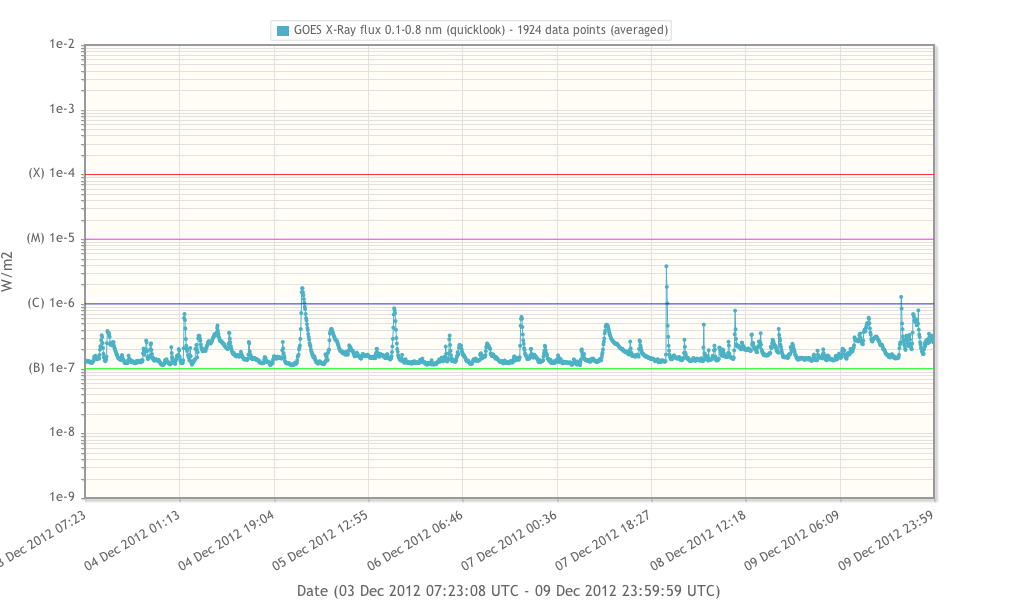
Three partial halo CMEs were observed this week.
A partial halo CME on December 5, was first observed in the SOHO/LASCO C2 field of view at about 00:36 UT, had angular width of about 210 degrees, projected speed around 750 km/s and was directed eastward of the Sun-Earth line. It was associated with C1.7 flare from the Catania sunspot group 41 (NOAA AR 1628) situated close to the East solar limb. The associated CME-driven shock did not arrive at the Earth.
Second partial halo CME observed this week was on December 7, and was associated with the long duration B4.8 flare peaking at at 10:07 UT on December 7. The CME was first detected in the SOHO/LASCO C2 field of view at about 09:48 UT and had a speed of about 600 km/s, as reported by the CACTUS software. The CME was directed to the west of the Sun-Earth line, and only the CME-driven shock wave was expected at the Earth on afternoon of December 10.
The strongest flare of the week, C3.9 flare on December 7, was associated with a partial halo CME which due to the source active region position at the West solar limb was not expected to arrive to the Earth.
Geomagnetic conditions were quiet this week. The local station at Dourbes reported values up to K=2 during the week and only one short interval of K=3 (on December 9). During the whole week, the Earth was inside a slow solar wind flow, with the maximum of the solar wind speed of about 450 km/s reached on December 4. The interplanetary magnetic field (IMF) magnitude was slightly elevated, with the maximum value of about 10 nT, during the first half of the week. Since early December 4 the value of the IMF decreased to about 5 nT and stayed so during the rest of the week.
It was a very calm week on the Sun. With a single C1 flare on Monday, solar activity switched daily between *low* and *very low*. Only 4 C1-level flares were recorded during the whole week.
In order to view the activity of this week in more detail, we suggest to go to the following website from which all the daily (normal and difference) movies can be accessed: http://proba2.oma.be/ssa.
This page also lists the recorded flaring events.
Some minor events of this week are presented below:
A C1 flare eruption on the N-E limb, on Wednesday 05, 00:20 UT.
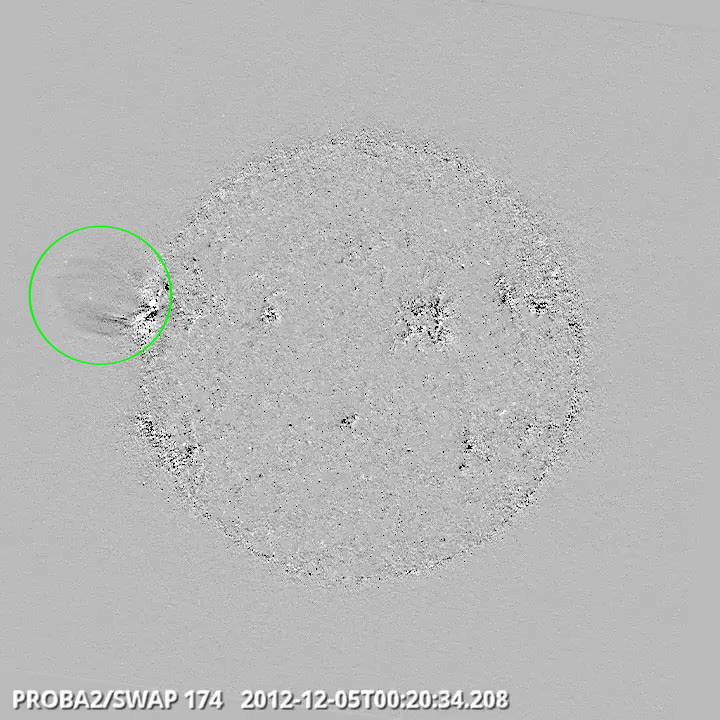
On Sunday 09th, a filament activation occurred in the NE quadrant: see the SWAP difference movie on http://proba2.oma.be/swap/data/mpg/movies/campaign_movies/20121209_FilaErup_0700-1000_swap_diff.mp4 and in H-alpha: http://halpha.nso.edu/keep/ham/201212/20121209/20121209000000Uh.html
Knowledge of the background solar wind is an important input for CME propagation studies. Since in-situ measurements of the background solar wind are only available at 1 AU, we have to rely on heliospheric models to derive the distribution of solar wind parameters in IP space and hence, to do space weather forecasting. We test the performance of the solar wind models ENLIL/MAS, ENLIL/WSA (CCMC) and MAS (Predictive Science) by comparing model results with in-situ measurements from ACE and Wind. For the study we chose the years 2005 and 2007 as a time period with low solar activity. We found that the general structure of the background solar wind is well reproduced by the models. The best model results were obtained for the parameter solar wind speed. However, the predicted arrival times of high speed solar wind streams have typical uncertainties of the order of 1 – 1.5 days.
http://www.spaceweather.eu/en/repository/show?id=339
European Space Weather Landscape: Current Perspectives and Requirements for the Future
http://www.spaceweather.eu/en/repository/show?id=340
European Space Weather Landscape: Current Perspectives and Requirements for the Future
http://www.spaceweather.eu/en/repository/show?id=341
European Space Weather Landscape: Current Perspectives and Requirements for the Future
http://www.spaceweather.eu/en/repository/show?id=342
European Space Weather Landscape: Current Perspectives and Requirements for the Future
http://www.spaceweather.eu/en/repository/show?id=343
European Space Weather Landscape: Current Perspectives and Requirements for the Future
http://www.spaceweather.eu/en/repository/show?id=344
European Space Weather Landscape: Current Perspectives and Requirements for the Future
http://www.spaceweather.eu/en/repository/show?id=345
European Space Weather Landscape: Current Perspectives and Requirements for the Future
http://www.spaceweather.eu/en/repository/show?id=346
European Space Weather Landscape: Current Perspectives and Requirements for the Future
http://www.spaceweather.eu/en/repository/show?id=347
European Space Weather Landscape: Current Perspectives and Requirements for the Future
http://www.spaceweather.eu/en/repository/show?id=348
Innovations and Key Challenges in Space Weather Science
http://www.spaceweather.eu/en/repository/show?id=349
Innovations and Key Challenges in Space Weather Science
http://www.spaceweather.eu/en/repository/show?id=350
Innovations and Key Challenges in Space Weather Science
http://www.spaceweather.eu/en/repository/show?id=351
Innovations and Key Challenges in Space Weather Science
http://www.spaceweather.eu/en/repository/show?id=352
Innovations and Key Challenges in Space Weather Science
http://www.spaceweather.eu/en/repository/show?id=353
Innovations and Key Challenges in Space Weather Science
http://www.spaceweather.eu/en/repository/show?id=354
Innovations and Key Challenges in Space Weather Science
http://www.spaceweather.eu/en/repository/show?id=355
Innovations and Key Challenges in Space Weather Science
http://www.spaceweather.eu/en/repository/show?id=356
Innovations and Key Challenges in Space Weather Science
http://www.spaceweather.eu/en/repository/show?id=357
Solar Variability Effects on Climate
http://www.spaceweather.eu/en/repository/show?id=358
Solar Variability Effects on Climate
http://www.spaceweather.eu/en/repository/show?id=359
Solar Variability Effects on Climate
http://www.spaceweather.eu/en/repository/show?id=360
Solar Variability Effects on Climate
http://www.spaceweather.eu/en/repository/show?id=361
Solar Variability Effects on Climate
http://www.spaceweather.eu/en/repository/show?id=362
Solar Variability Effects on Climate
http://www.spaceweather.eu/en/repository/show?id=363
Solar Variability Effects on Climate
http://www.spaceweather.eu/en/repository/show?id=364
Coupled Space Weather Modelling
http://www.spaceweather.eu/en/repository/show?id=365
Coupled Space Weather Modelling
http://www.spaceweather.eu/en/repository/show?id=366
Coupled Space Weather Modelling
http://www.spaceweather.eu/en/repository/show?id=367
Coupled Space Weather Modelling
http://www.spaceweather.eu/en/repository/show?id=368
Coupled Space Weather Modelling
http://www.spaceweather.eu/en/repository/show?id=369
Coupled Space Weather Modelling
http://www.spaceweather.eu/en/repository/show?id=370
Coupled Space Weather Modelling
http://www.spaceweather.eu/en/repository/show?id=371
Coupled Space Weather Modelling
http://www.spaceweather.eu/en/repository/show?id=372
Coupled Space Weather Modelling
http://www.spaceweather.eu/en/repository/show?id=373
Spacecraft Operations and Space Weather
http://www.spaceweather.eu/en/repository/show?id=374
Spacecraft Operations and Space Weather
http://www.spaceweather.eu/en/repository/show?id=375
Spacecraft Operations and Space Weather
http://www.spaceweather.eu/en/repository/show?id=376
Spacecraft Operations and Space Weather
http://www.spaceweather.eu/en/repository/show?id=377
Spacecraft Operations and Space Weather
http://www.spaceweather.eu/en/repository/show?id=378
Spacecraft Operations and Space Weather
http://www.spaceweather.eu/en/repository/show?id=379
Space Weather in the Solar System
http://www.spaceweather.eu/en/repository/show?id=381
Space Weather in the Solar System
http://www.spaceweather.eu/en/repository/show?id=382
Space Weather in the Solar System
http://www.spaceweather.eu/en/repository/show?id=383
Space Weather in the Solar System
http://www.spaceweather.eu/en/repository/show?id=384
Space Weather in the Solar System
http://www.spaceweather.eu/en/repository/show?id=385
Space Weather in the Solar System
http://www.spaceweather.eu/en/repository/show?id=386
Space Weather in the Solar System
http://www.spaceweather.eu/en/repository/show?id=387
COST ES0803 Final Results
http://www.spaceweather.eu/en/repository/show?id=388
COST ES0803 Final Results
http://www.spaceweather.eu/en/repository/show?id=389
COST ES0803 Final Results
http://www.spaceweather.eu/en/repository/show?id=390
COST ES0803 Final Results
http://www.spaceweather.eu/en/repository/show?id=391
COST ES0803 Final Results
http://www.spaceweather.eu/en/repository/show?id=392
COST ES0803 Final Results
http://www.spaceweather.eu/en/repository/show?id=393
COST ES0803 Final Results
http://www.spaceweather.eu/en/repository/show?id=394
COST ES0803 Final Results
http://www.spaceweather.eu/en/repository/show?id=395
COST ES0803 Final Results
http://www.spaceweather.eu/en/repository/show?id=396
Spacecraft Operations and Space Weather
http://www.spaceweather.eu/en/repository/show?id=397
ESWW9 Splinter wrap up
http://www.spaceweather.eu/en/repository/show?id=398
Presentation given at the conference 'Solar and Heliospheric influences on the geospace', Bucharest, Romania in the session 'Education, dissemination, outreach'
http://www.spaceweather.eu/en/repository/show?id=399
A presentation given for the members of the public observatory 'Armand Pien', Gent: 60 participants.
http://www.spaceweather.eu/en/repository/show?id=400
On October 27, this Dutch presentation was given about Solar Cycle 24 for a group of amateur astronomers, namely the Workgroup Sun of the VVS and the NVWS, 20 people.
http://www.spaceweather.eu/en/repository/show?id=401
http://www.spaceweather.eu/en/repository/show?id=402
Start : 2013-01-14 - End : 2013-01-17
The Atacama Large Millimeter/submillimeter Array (ALMA), an
international partnership of Europe, North America and East Asia in
cooperation with the Republic of Chile, is the largest astronomical
project in existence.
The workshop aims to bring together the ALMA-minded solar
community to discuss solar observational issues with ALMA, solar
science and planned observations with ALMA, and the planning of
solar ALMA observations.
Th workshop is hosted by Astronomy & Astrophysics Group,
and will take place in School of Physics and Astronomy, University
of Glasgow, Room 323, Kelvin Building.
Website:
http://www.astro.gla.ac.uk/~eduard/solarALMA/
Start : 2013-02-04 - End : 2013-02-08
Helioseismology provides tools for imaging structures and mass
flows below the solar surface, and is becoming an essential
technique for understanding the dynamics of solar activities and
developing physics-based forecasts of the solar cycle, emerging
active regions and energy release events. A better understanding is
needed to unravel the effects of the complex interactions of solar
oscillations with the turbulent magnetized plasma
on global and local helioseismology
diagnostics. These effects are particularly challenging in regions
of strong magnetic fields. Numerical simulations of solar MHD waves
and turbulent dynamics give important insights into the complicated
wave and turbulence physics, and provide synthetic data for
verification and validation of helioseismology methods and
results.
The goals of this workshop are to discuss and stimulate further
development of helioseismology methods, solar interior models, and
realistic numerical simulations. These goals are particularly
important for analysis of the continuous data flow from the Solar
Dynamics Observatory, development and verification of
helioseismology methods, and for theoretical interpretation of
observations and inversion results.
Website:
http://sun.stanford.edu/LWS2013/
Start : 2013-02-28 - End : 2013-02-28
On February 28th, 2013 the AFFECTS team organises an
international user workshop at the Royal Observatory of Belgium in
Brussels.
At the workshop there will be a demonstration of all AFFECTS
space weather
products:
* Near real time dimming and EIT
wave detection
* 3D CME
analysis tool
* Coronal analysis tool
* CME
& solar wind
arrival and impact forecast
tool
* Flare, CME
, geomagnetic, auroral, ionospheric
forecasts & alerts
* Forecast of perturbed TEC
* Solar activity and space weather
timelines viewer
To register, please send an e-mail incl. your full name,
institution, e-mail and (institutional) address to
.
Dörte Dannemann
Website:
http://www.affects-fp7.eu/news-events/user-ws/
Start : 2013-03-04 - End : 2013-03-06
Geant4 Space Users' Workshop -G4SUW- is focused on new
results on space radiation interaction with components, sensors and
shielding analysis, as well as on Geant4-based tools and
developments applicable to space missions.
The Geant4 particle transport toolkit is jointly developed by a
world-wide collaboration and is intended for a wide range of
applications in HEP, medical field, and space physics and
engineering. In recent years, space and astrophysics has become a
significant user category, with applications ranging from
instrument and detector response verification to space radiation
shielding optimization, component effects, support of scientific
studies, and analysis of biological effects.
Main topics for next G4SUW will include:
* Single Event Effects (SEE) simulation.Geant4-TCAD
coupling.
* Microdosimetry.
* Planetary exploration applications.
* Space electronics and science detectors.
* Simulation of astronaut radiation hazards.
* Interfaces and tools to space environment analysis tools such
as SPENVIS.
* Cosmic ray magnetospheric propagation analysis.
* Large-scale simulations requiring event biasing and/or GRID
capabilities.
* General shielding optimization applications.
Website:
http://www.inta.es/g4suw2013/index.html
Start : 2013-04-07 - End : 2013-04-12
The EGU General Assembly 2013 will bring together geoscientists
from all over the world into one meeting covering all disciplines
of the Earth, Planetary and Space Sciences. Especially for young
scientists, it is the aim of the EGU to provide a forum where they
can present their work and discuss their ideas with experts in all
fields of geosciences. The EGU is looking forward to cordially
welcoming you in Vienna.
Website:
http://www.egu2013.eu/home.html
Start : 2013-04-08 - End : 2013-04-12
The most recent solar minimum, solar cycle 23-24 minimum, was
unusually long (266 spotless days in 2008, the most since 1913),
and the magnetic field at the solar poles was approximately 40%
weaker than the last cycle; and unusually complex (the solar wind
was characterized by a warped
heliospheric current sheet, HCS, and fast-wind
streams at low latitudes: the
fast-wind
threads the ecliptic
more commonly in 2008 than 1996.)
This complexity resulted in many effects observed from Sun to
Earth, with many observations indicating unusual conditions on the
Sun, in the heliosphere
, and in the magnetosphere
, ionosphere
, and upper atmosphere of the
Earth.
This remarkable set of conditions provide the scientific
community with an exceptional opportunity to assess the nature and
structure of a very quiet Sun, and an upper atmosphere relatively
devoid of solar influences, helping to provide a better
understanding of the relative roles of solar activity and internal
variability in the dynamics of the Earth's upper atmosphere and
ionosphere
. Such an understanding requires a
multidisciplinary approach.
The main goal of the conference is to bring together the solar,
heliospheric, magnetospheric, upper atmosphere, and ionospheric
communities to debate and discuss interdisciplinary work and reach
a better understanding of the nature and structure of a very quiet
Sun, and of an upper atmosphere relatively devoid of solar
influences, and in doing so, to help clarify the role of solar
activity in the dynamics and variability of the Earth's upper
atmosphere and ionosphere
relative to the internal
variations.
Website:
http://chapman.agu.org/solarminimum/
Start : 2013-05-06 - End : 2013-05-10
In the last 50 years, helioseismology has made significant
contributions to the knowledge of the Sun's interior physics
and has led the way to asteroseismology. We have now reached an era
where more sophisticated questions are being asked to understand
the subtle properties of the Sun and other stars due to the
synoptic and high-resolution observations available from BISON,
GONG and space missions such as SOHO
, SDO, CoRot and Kepler.
On this occasion, a workshop on the theme of '50 years of the
seismology of the Sun and stars' is being organized to reflect the
progress that has been made as well as to focus on future goals. We
plan to bring together helio- and asteroseismologists, theorists
and observers in a journey that will take us from the interior of
the Sun and its magnetism towards the structure of distant stars
and activity cycles.
Website:
http://www.nso.edu/workshops/2013
Start : 2013-06-23 - End : 2013-06-29
The 2013 ILWS Science Workshop will take place June 23-29, 2013
in Irkutsk, Russia and will be hosted by the Institute of
Solar-Terrestrial Physics of the Russian Academy of Sciences
Website:
http://en.iszf.irk.ru/ILWS_2013
Start : 2013-07-12 - End : 2013-07-19
Applications are invited for the 2013 Heliophysics Summer
School, which will be held in beautiful Boulder, Colorado. We are
seeking students and undergraduate level teachers and instructors
to join us this coming summer for a unique professional experience.
Students and teachers will learn about the exciting science of
heliophysics as a broad, coherent discipline that reaches in space
from the Earth's troposphere to the depths of the Sun, and in
time from the formation of the solar system to the distant future.
At the same time, a goal of the Summer School is for the group of
instructors to develop materials from Heliophysics that can be
applied in their classes.
The Heliophysics Summer School focuses on the physics of space
weather events that start at the Sun and influence atmospheres,
ionospheres and magnetospheres throughout the solar system. The
solar system offers a wide variety of conditions under which the
interaction of bodies with a plasma environment can be studied:
there are planets with and without large-scale magnetic fields and
associated magnetospheres; planetary atmospheres display a variety
of thicknesses and compositions; satellites of the giant planets
reveal how interactions occur with subsonic and sub-Alfvenic flows
whereas the solar wind interacts with supersonic and super-Alfvenic
impacts.
Encompassed under a general title of comparative magnetospheres
are processes occurring on a range of scales from the solar wind
interacting with comets to the interstellar medium interacting with
the heliosphere. The school will address not only the physics of
all these various environments but will also go into the
technologies by which these various environments are being
observed. The program is complemented with considerations of the
societal impacts of space weather that affects satellites near
Earth and elsewhere in the solar system.
The school will be based on lectures, laboratories, and
recitations from world experts, and will draw material from the
three textbooks Heliophysics I-III, published by Cambridge
University Press.
Several teachers along with about 35 students will be selected
through a competitive process organized by the UCAR Visiting
Scientist Programs. The school lasts for eight days, and each
participant receives full travel support for airline tickets,
lodging and per diem costs.
Website:
http://www.vsp.ucar.edu/Heliophysics/
Start : 2013-07-16 - End : 2013-07-25
The Summer School Alpbach enjoys 36 years of tradition in
providing in-depth teaching on different topics of space science
& technology, featuring lectures and concentrated working
sessions on mission studies in self-organised working groups. 60
young highly qualified European science and engineering students
converge annually for stimulating 10 days of work in the Austrian
Alps. 4 teams compete to design a space mission judged by a jury of
experts. Students learn how to approach the design of a satellite
mission and explore new and startling ideas supported by experts.
The Summer School 2013 will focus on Space Weather
.
The purpose of the Summer School is to foster the practical
application of knowledge derived from lectures, to develop
organisational and team-work skills and to encourage creativity.
Teams will compete to design the best project, judged by an
independent jury. The teams themselves are responsible for the
selection of the subject of the project and for the team structure
and working methods.
Website:
http://www.summerschoolalpbach.at/
Start : 2013-09-09 - End : 2013-09-14
We gain information about the universe through analysis of the
spectra from celestial objects. However, while the intensity
spectrum represents a scalar quantity but electromagnetic radiation
occurs in the form of transverse waves, the polarized spectrum
provides us with a 4-vector, the Stokes vector. The increased
amount of information space opens new windows to the universe, in
particular for the exploration of magnetic fields. It is well
recognized that the magnetic field is a primary agent responsible
for structuring and the source of all variability on intermediate
time scales, which manifests itself in all forms of solar and
stellar activity.
It is therefore not surprising that every year there are many
scientific meetings organized with the objective of studying the
role of magnetic fields in cosmic objects. What is largely missing
in these meetings is however an in-depth investigation of the
fundamental aspects of how magnetic fields can be determined by the
means of spectro-polarimetry, our main gateway to cosmic magnetism.
The primary aim of our series of Workshops is to address these
fundamental aspects, with less emphasis on the morphological and
physical properties of cosmic magnetic fields.
Website: http://spw7.ynao.ac.cn/
Start : 2013-11-18 - End : 2013-11-22
The 10th Edition of the European Space Weather
Week will take place on 18-22nd
November 2013 in Belgium. The venue will be confirmed early next
year, but mark your calendars now for the 10th Anniversary of this
growing European event.
The ESWW will again adopt the central aim of bringing together
the diverse groups in Europe working on different aspects of Space
Weather
. This includes but isn't
limited to the scientific community, the engineering community,
applications developers, service providers and service end users.
The meeting organisation will again be coordinated by the Belgian
Solar-Terrestrial Centre of Excellence (STCE), ESA
and the Space Weather
Working Team. The local
organisation will be done by the STCE.
Website: not yet available
Start : 2014-08-02 - End : 2014-08-10
The 40th COSPAR Scientific Assembly will be held in Moscow,
Russia from 2 - 10 August 2014. This Assembly is open to all bona
fide scientists.
Website:
http://www.cospar-assembly.org/